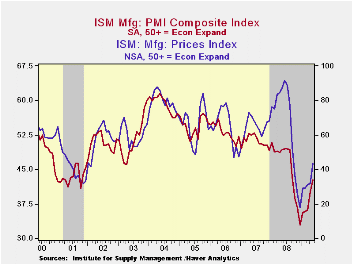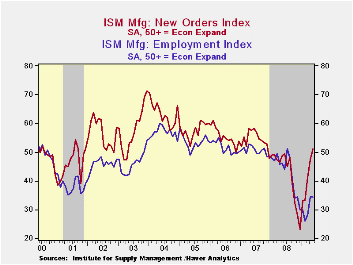 Global| Jun 01 2009
Global| Jun 01 2009ISM Index Suggests Downturn In Factory Sector Is Easing
by:Tom Moeller
|in:Economy in Brief
Summary
The manufacturing sector showed a further sign of modest improvement after its sharp decline in overall activity. The May composite index for the factory sector from the Institute for Supply Management rose to 42.8 from 40.1 in April. [...]

The manufacturing sector showed a further sign of modest improvement after its sharp decline in overall activity. The May composite index for the factory sector from the Institute for Supply Management rose to 42.8 from 40.1 in April. Though the latest figure still indicates a lower level of activity, as does any below the break-even point of 50, the rate of decline appears to be easing. The worst of the decline was at yearend '08 when the index reached 32.9. Consensus expectations were for a May reading of 42.3.
Improvement in the May components of the overall ISM index was limited, but encouraging. The new orders figure broached the break-even level of 50 for the first time since late 2007 with a rise to 51.1. The improvement came as only 19% (NSA) of survey participants reported lower orders ,versus a December high of 64%, while a still-low 27% reported higher orders. The export order index also improved to 48.0 versus the December reading of 35.5. During the last ten years there has been a 53% correlation between the index and the q/q change in real exports of goods in the GDP accounts.
The production component also improved to a level of 46.0, which was its highest level since August and up off the low of 26.3 in December. During the last ten years there has been an 84% correlation between the level of the production component of the composite index and the three-month growth in factory sector industrial production. It is appropriate to correlate the ISM index level with factory sector output growth because the ISM index is a diffusion index. It measures growth by using all of the positive changes in activity added to one half of the zero change in activity measures. Another glimmer of improvement was that the speed of supplier deliveries slowed for the second month.
Elsewhere, improvement in the components was limited. The employment index was unchanged at a low reading of 34.3, though that was up from the February low. During the last ten years there has been an 89% correlation between the index level and the one-month change in manufacturing payrolls. Continued destocking played a role in that weakness as suggested by a low inventory index reading of 32.9 which was near the lowest level since 1982.
The separate index of prices paid rose sharply indicating that pricing power is rebuilding with improved activity levels. The reading of 43.5 was its highest since last September. During the last twenty years there has been a 79% correlation between the price index and the three-month change in the PPI for intermediate goods.
The ISM data is available in Haver's USECON database.
Positive Economic Signs Are Emerging; Recovery Will Take Time from the Federal Reserve Bank of St. Louis can be found here.
| ISM Mfg | May | April | May '08 | 2008 | 2007 | 2006 |
|---|---|---|---|---|---|---|
| Composite Index | 42.8 | 40.1 | 49.3 | 45.5 | 51.1 | 53.1 |
| New Orders Index | 51.1 | 47.2 | 48.6 | 42.1 | 54.3 | 55.4 |
| Employment Index | 34.3 | 34.4 | 46.2 | 43.2 | 50.5 | 51.7 |
| Prices Paid Index (NSA) | 43.5 | 32.0 | 87.0 | 66.5 | 64.6 | 65.0 |
Tom Moeller
AuthorMore in Author Profile »Prior to joining Haver Analytics in 2000, Mr. Moeller worked as the Economist at Chancellor Capital Management from 1985 to 1999. There, he developed comprehensive economic forecasts and interpreted economic data for equity and fixed income portfolio managers. Also at Chancellor, Mr. Moeller worked as an equity analyst and was responsible for researching and rating companies in the economically sensitive automobile and housing industries for investment in Chancellor’s equity portfolio. Prior to joining Chancellor, Mr. Moeller was an Economist at Citibank from 1979 to 1984. He also analyzed pricing behavior in the metals industry for the Council on Wage and Price Stability in Washington, D.C. In 1999, Mr. Moeller received the award for most accurate forecast from the Forecasters' Club of New York. From 1990 to 1992 he was President of the New York Association for Business Economists. Mr. Moeller earned an M.B.A. in Finance from Fordham University, where he graduated in 1987. He holds a Bachelor of Arts in Economics from George Washington University.






